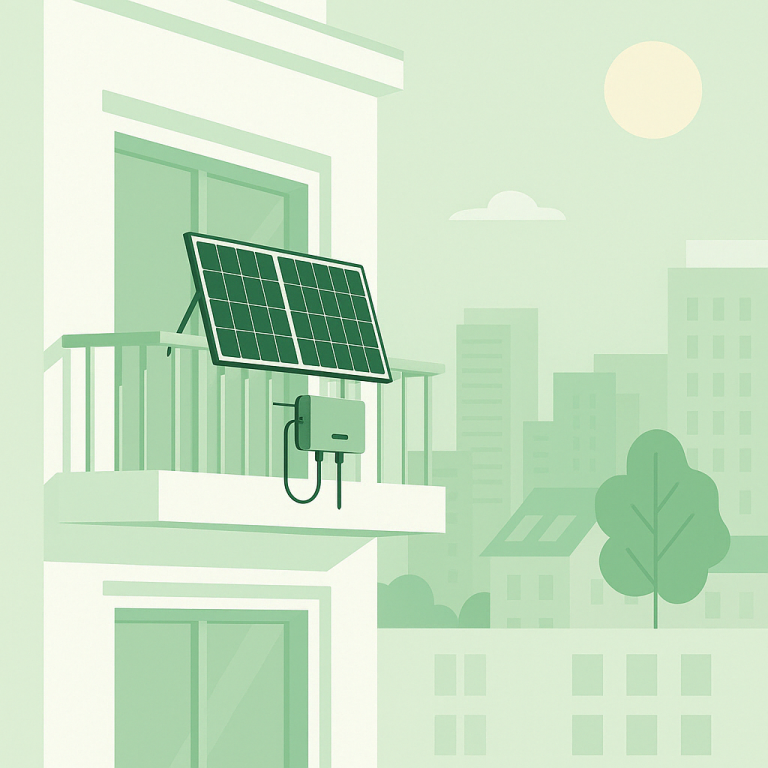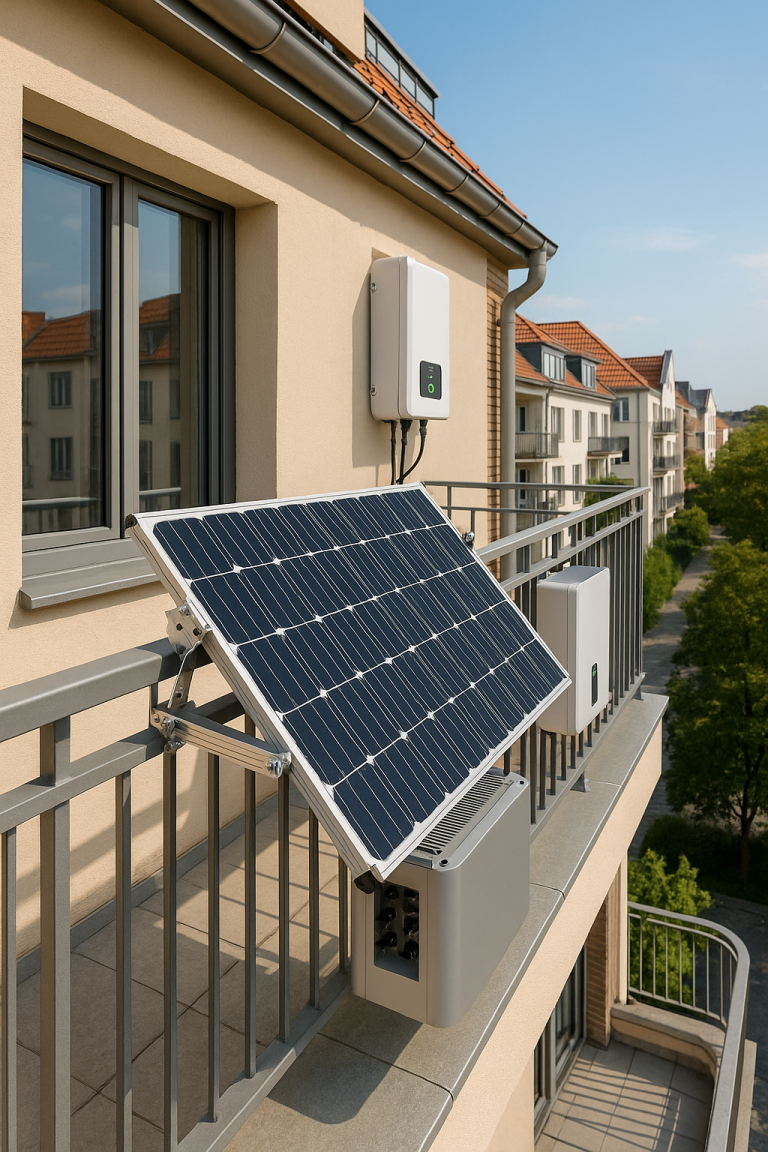1. Introduction: Why 1000W Balcony Solar Systems Are Trending
Across Europe, balcony solar systems have evolved from niche DIY kits into powerful, scalable solutions for urban energy independence. As electricity prices rise and plug-and-play solutions become smarter, homeowners and renters alike are asking:
“Should I go with 600W, 800W, or even 1000W on my balcony?”
The 1000W solar system is becoming a serious contender — but is it too much for a typical EU apartment balcony?
In this article, we break down the technical feasibility, legal landscape, benefits, downsides, and real-life use cases for 1000W systems in the EU, especially in countries like Germany, Austria, the Netherlands, and France.
2. What Is a 1000W Solar System and What Does It Include?
A 1000W (1kW) solar system typically consists of:
- 2–3 high-efficiency panels (350W–500W each)
- Micro or hybrid inverter (1kW rated output)
- Smart meter or energy monitor
- Optional: LiFePO₄ battery system (5kWh–10kWh)
- Optional: MPPT charge controller if off-grid
Such systems are designed for:
- Plug-and-play balcony rail mounting
- Wall-mounted storage
- Easy integration with home appliances
Depending on sunlight and placement, a 1000W system can generate 3–5kWh per day in summer — enough to power:
- Fridge
- Internet & Wi-Fi router
- Lights & laptop
- TV and small appliances
3. EU Regulations: Is 1000W Legal in Germany and Neighboring Countries?
This is the most common concern — what’s legally allowed?
?? Germany
- Grid feed-in via balcony solar kits is regulated under DIN VDE 0100-551 and 4105
- Max inverter output allowed for plug-and-play without professional installation = 800W (Rising to 800W + 200W buffer in 2024–2025 updates)
- 1000W system can be legal if:
- Limited to 800W AC export via software
- Registered via MaStR (German Market Master Data Register)
- Installed with compliant inverters
?? Austria
- 800W limit for single-phase grid injection, 1500W possible with permission
?? Netherlands
- Up to 600–800W plug-and-play widely accepted; >1000W requires electrician
?? France
- No strict micro PV limit, but formal Enedis registration required for export systems
✅ In short:
Yes, 1000W systems are allowed across Europe when:
- Grid output is software-limited
- Systems are registered and installed per regulation
- Off-grid or storage use is preferred
4. Pros of a 1000W Balcony Setup
Despite regulatory nuance, 1000W kits offer major advantages:
? More Power
- Greater daily output = more appliance coverage
- Offsets more of your grid electricity bill
? Better ROI
- Higher total yield = faster payback
- Especially with tiered electricity rates in Germany or France
? Battery Integration
- Enough excess energy to charge 5–10kWh LiFePO₄ storage
- Enables nighttime usage or blackout backup
?️ Seasonal Buffer
- Performs better during low sun months (winter, cloudy days)
? Ready for Growth
- Easy to upgrade with future home expansions or additional batteries
5. Cons and Limitations
However, 1000W setups aren’t always the best fit. Consider:
⚖️ Structural Load
- Panels + mount + inverter = ~20–40kg
- Verify balcony railing strength and wind resistance
? Grid Export Limit
- Even with 1000W generation, you may only feed in 600–800W
- Excess must go to battery or be capped
? Installation Complexity
- Requires larger inverter, stronger mounts, and more safety gear
- Professional installation may be required in some regions
? Paperwork
- Must register with local authorities (e.g., MaStR in Germany)
- Noncompliance can result in fines or forced disconnection
6. When Is 1000W the Right Choice? 5 Realistic Use Cases
✅ Use Case #1: Small Home Office
- Solar powers your monitor, laptop, router, lights for 8–10 hrs/day
- Battery stores energy for overnight use
✅ Use Case #2: Tenant in Germany with High Daytime Use
- Fridge, air fryer, and vacuum run during daylight
- 1000W + smart inverter = max savings
✅ Use Case #3: Off-Grid Cabin or Garden House
- No grid? No problem. Charge battery bank + run AC devices directly
- Great for rural France, Spain, Nordic areas
✅ Use Case #4: Solar Enthusiast with Battery Bank
- Pair with 10kWh stackable battery to maximize ROI
- Allows for “self-consumption-first” setup
✅ Use Case #5: Seasonal Use (Airbnb, Summer Apartment)
- Offset cooling and lighting loads
- Payback faster in southern Europe climates
7. Comparing 600W vs 800W vs 1000W – What Changes?
| Feature | 600W | 800W | 1000W |
|---|---|---|---|
| Legal Simplicity | ✅ Fully legal | ✅ Still simple | ⚠️ Requires setup |
| Daily Yield (avg) | ~2.5 kWh | ~3.5 kWh | ~5.0 kWh |
| Grid Export | 600W max | 800W max | 800W max (capped) |
| Suitable for Battery | Limited | Moderate | ✅ Ideal |
| DIY-Friendly | ✅ Yes | ✅ Yes | ⚠️ Often requires help |
8. Best Battery Pairing for a 1000W System
To make the most of a 1000W kit, pairing with a LiFePO₄ battery is highly recommended.
? Suggested Specs:
| Use Case | Suggested Capacity |
|---|---|
| Day-to-night use | 5kWh |
| Backup power | 7–10kWh |
| Off-grid cabin | 10–15kWh |
✅ Features to look for:
- 51.2V wall-mounted battery
- Smart BMS with Bluetooth/Wi-Fi
- CAN/RS485 compatibility for hybrid inverters
- Certifications: CE, UN38.3, IEC 62619
9. Installation Tips: Mounting, Inverters & Smart Monitoring
?️ Mounting:
- Use balcony rail clamps rated for wind loads
- Prefer angled frames (15°–30°) for better sunlight exposure
- Keep panels at least 15 cm from wall for airflow
? Inverter Setup:
- Use micro-inverter (e.g., Hoymiles) or hybrid inverter
- If exporting to grid, software-limit to 600–800W
- Install DC isolator for safety
? Monitoring:
- Use plug-based smart meters or solar apps
- Some kits include real-time energy dashboards via app/web
10. Conclusion: Is 1000W the Future of Urban Solar in Europe?
If you want more energy independence, faster ROI, or battery support, 1000W is a great option — as long as you follow:
- ?? Local legal export limits
- ⚙️ Proper installation safety
- ? Battery pairing for maximum benefit
- ? Registration requirements
In 2025 and beyond, 1000W will likely become the new normal for advanced plug-and-play solar systems — especially in energy-aware countries like Germany and the Netherlands.
☀️ Go bigger, go smarter — your balcony has more potential than you think.




